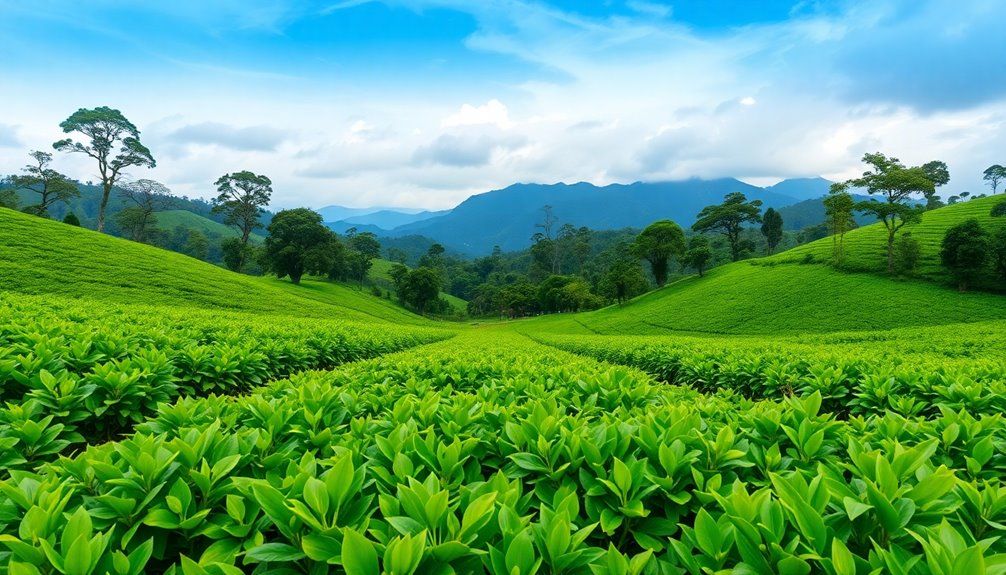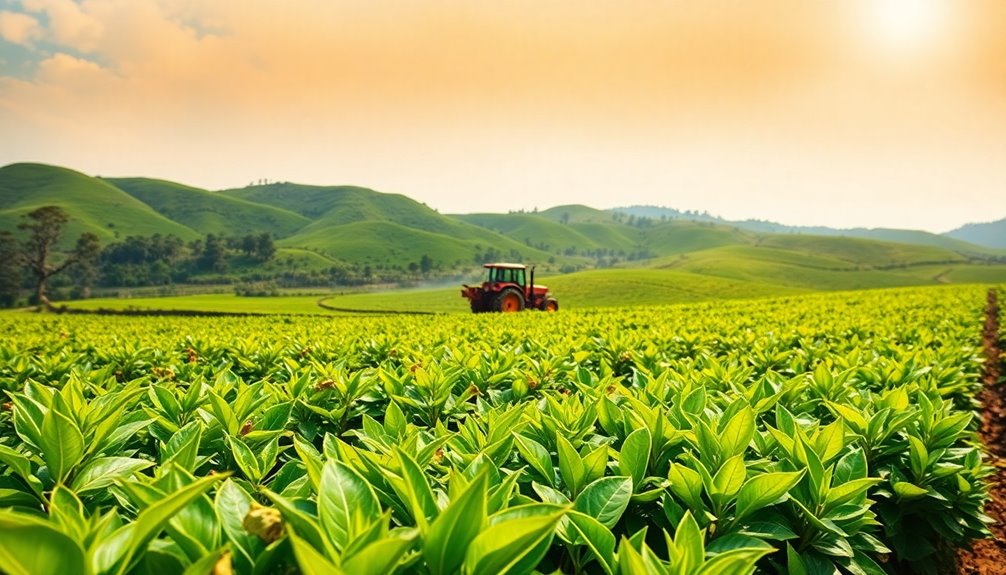Climate change is shaking up the tea industry, and you need to be aware. Rising temperatures and unpredictable weather threaten tea harvests, especially in key areas like Kenya, where over 25% could become unsuitable by 2050. Drought and heavy rainfall hurt crop quality and yield, while increased pest populations further complicate matters. It's not just about the plants; labor shortages are becoming common as young workers look for more stable jobs. Farmers are adapting with new varieties, but challenges remain. You might find it interesting to discover how stakeholders are responding to these pressing changes.
Key Takeaways
- Climate change is projected to render over 25% of tea-growing areas in Kenya uninhabitable by 2050, threatening global tea supply.
- Rising temperatures and erratic weather patterns disrupt traditional harvesting schedules, impacting tea quality and yield significantly.
- Increased pest populations, fueled by warmer climates and drought, lead to greater reliance on chemical pesticides for tea crops.
- Labor shortages in tea production are exacerbated by extreme weather events, prompting youth to seek employment in more stable sectors.
- Farmers are adapting by adopting drought-resistant cultivars and diversifying crops to mitigate climate-related impacts on tea cultivation.
Introduction

In the face of a rapidly changing climate, the tea industry finds itself at a critical crossroads. As a tea farmer, you're witnessing firsthand how climate change dramatically affects tea-growing regions. Projections suggest that by 2050, more than 25% of suitable areas in places like Kenya could become uninhabitable for tea cultivation. This shift could threaten your tea yield and quality, as extreme weather events like erratic rainfall and increased droughts become more frequent.
Global warming isn't just an environmental issue; it's an economic one too. With over 13 million people relying on the tea sector worldwide, the viability of tea farms hangs in the balance. You might find that rising temperatures and altered phytochemical properties impact market prices and consumer preferences, pushing you to reconsider your farming practices.
Adaptation strategies are essential for survival. Embracing drought-resistant cultivars and diversifying crops can help mitigate climate impacts. These strategies won't only sustain tea production but also ensure that you and fellow tea farmers can continue your livelihood despite the challenges posed by climate change.
Tea Harvests and Temperature Shifts

Temperature shifts are reshaping the landscape of tea harvests, presenting significant challenges for farmers like you. Climate change is causing rising temperatures that threaten the suitability of optimal tea-growing areas. For instance, projections suggest that Kenya's prime tea region may shrink by over 25% by 2050.
Extreme weather events, such as heatwaves and prolonged drought, have already devastated thousands of acres of tea trees in China, leading to significant crop losses.
Unpredictable seasonal changes complicate traditional tea production, delaying harvesting and disrupting your customary picking schedules. These changes not only affect your operational routines but also the quality of the tea. Increased rainfall and flooding can dilute the secondary metabolites, which are vital for flavor and health benefits, resulting in a product that may not meet market standards.
As these adverse effects mount, the economic stability of tea-growing regions is increasingly at risk. Many young individuals are now seeking alternatives to tea farming, driven by the challenges posed by shifting temperatures and extreme weather.
Adapting to these changes is essential for sustaining your livelihood in a rapidly evolving climate landscape.
Rising Pest Populations Threaten Crops

Rising pest populations threaten your tea crops, creating an urgent challenge for farmers in a warming climate. Climate change has led to warmer temperatures, enhancing the reproductive rates and survival of pests that target tea plants. As infestations increase, you may face significant crop damage, ultimately impacting your tea yields and quality.
Drought conditions, worsened by climate change, weaken your tea plants, making them more vulnerable to these pests. Additionally, shifts in precipitation patterns disrupt the natural predators that typically keep pest populations in check, leading to a greater reliance on chemical pesticides. This reliance can harm the environment and diminish the overall health of your crops.
Research shows that climate-related stresses can decrease the secondary metabolites in your tea plants, which are vital for defending against pests. Without these natural defenses, your crops face even greater threats, compounding the challenges you already encounter.
As pest populations rise and the climate continues to change, it's crucial to adopt integrated pest management strategies that not only protect your tea crops but also promote sustainability and resilience in your farming practices.
Shifts in Regional Tea Varieties

As climate change reshapes the landscape of tea cultivation, you're likely to see a significant shift in the regions where tea can thrive. The IPCC projects that by 2050, over 25% of tea-growing areas in Kenya may become unsuitable due to rising temperatures. This change forces tea producers to explore new regions, as traditional tea-growing areas in India, China, and Sri Lanka face declining productivity from climate stressors.
In response to the impact of climate change, farmers are increasingly adopting drought-resistant tea cultivars and diversifying their crops. These cultivars offer a buffer against the challenges posed by erratic weather patterns.
However, the trend toward higher-producing clonal tea varieties raises concerns about their shallower root systems, making them more vulnerable to drought.
While some new regions may benefit from climate shifts, the overall landscape of tea cultivation is changing dramatically. You may witness not just a shift in geographical hotspots for tea production but also in the types of tea being cultivated.
As the climate continues to evolve, staying informed about these shifts will be essential for anyone involved in the tea industry.
Labor Shortages During Extreme Weather

Extreme weather events are wreaking havoc on the tea industry, making labor shortages a pressing issue. In tea-producing regions, prolonged droughts and heavy rainfall have caused significant crop damage. For instance, in China, thousands of acres of tea trees have perished due to ongoing drought conditions, resulting in fewer healthy plants and a decreased need for workers during harvesting.
Young individuals in these areas increasingly seek alternatives to tea farming, driven by the challenges posed by climate change. As erratic weather patterns complicate traditional tea cultivation, farmers struggle to maintain consistent yields, leading to further labor shortages. With the economic viability of tea farms increasingly threatened, workers are gravitating towards more stable employment opportunities in other sectors.
This situation creates a vicious cycle—fewer workers lead to less efficient harvesting and management of damaged crops, ultimately diminishing the industry's resilience.
As the tea industry grapples with these labor shortages during extreme weather, the need for innovative solutions becomes more urgent than ever. If these trends continue, the future of tea cultivation could be at serious risk, jeopardizing livelihoods and the global tea market.
Practical Applications

Numerous practical applications can help the tea industry adapt to the challenges posed by climate change. For smallholder farmers, implementing adaptation strategies is crucial to safeguard their livelihoods. One key approach is the introduction of drought-resistant cultivars in tea plantations, which can mitigate the impact of rising temperatures and reduced tea yields. These cultivars enable farmers to maintain production levels even during droughts, thus supporting the economic sustainability of the tea sector.
Additionally, intercropping can enhance soil health and provide alternative income sources, helping farmers diversify their earnings amidst the unpredictability of the global climate.
However, as climate change alters the flavor profile of tea, it's essential to monitor and adjust cultivation practices to preserve the quality that consumers expect.
The economic impacts of climate change are significant, with over 3 million people employed in Africa's tea sector alone. As weather patterns become increasingly erratic, young individuals may seek alternatives to traditional tea farming, further threatening the industry.
Conclusion
In conclusion, climate change is reshaping the tea industry in significant ways. As temperatures rise and pests become more prevalent, you may notice shifts in tea varieties and labor shortages during extreme weather events. It's crucial to acknowledge these challenges and adapt our practices to ensure the future of tea production. By staying informed and supporting sustainable methods, you can help protect this beloved beverage and the livelihoods of those who grow it.










